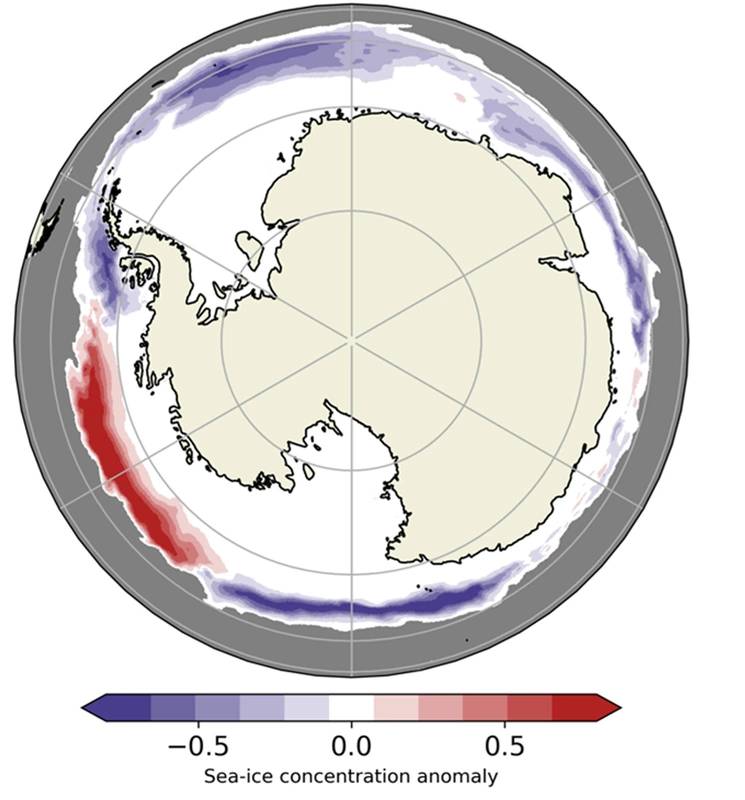Declining Antarctic sea ice cover is generating unprecedented ocean heat loss to the atmosphere and more storms, according to a new study led by the UK’s National Oceanography Centre (NOC).
The study, published in the journal Nature, focused on the record low Antarctic winter sea ice cover in 2023 and provides the first clear picture of the impacts of the disappearing sea ice.
Using data from the atmospheric layer just above the ocean surface, it found a doubling of heat loss to the atmosphere, matched by higher numbers of storms around much of the high latitude Southern Ocean.
The study also warns of potentially far-reaching impacts on the deeper ocean circulation, due to the heat loss making Antarctic surface waters denser than previously seen.
Lead author Professor Simon Josey said the results point to an urgent need to use state-of-the-art ocean and climate simulations, such as those currently undertaken by NOC, to better understand the broader impacts of Antarctic sea ice loss, which could ultimately extend to the Northern Hemisphere.
“It is too early to state whether 2023 and it’s record-breaking sea-ice decline marks the onset of a fundamental shift in the amount of Antarctic sea ice,” said Professor Josey, an expert on ocean-atmosphere interaction at NOC, which is a leader in ocean and climate research. “However, our study does reveal the extreme conditions to be expected in future years of low ice regrowth, with 2024 looking like it is continuing the sharp change seen in 2023.”
“Based on our study, years of low sea ice like this will continue to have more storms and greater changes to ocean properties that could impact the wider ocean circulation. Repeated low ice cover conditions in subsequent winters will strengthen these impacts and may result in profound changes further afield, including the Tropics and Northern Hemisphere.”
Sea ice cover provides a winter blanket over the high latitude Southern Ocean, which stops it from cooling through exposure to the atmosphere. With the blanket removed, heat is lost into the atmosphere and surface waters become cooler and denser.
Schematic representation of key processes.
Sea ice cover around Antarctica hit a record low in 2023, with ice reductions in strong loss regions 50 to 80 % below the 1991 to 2020 winter average. Ocean heat loss to the atmosphere at some locations has more than doubled and an increase in storms has been observed around much of the high latitude Southern Ocean by up to seven days a month.
Previous analysis of the long-term impacts of declining Antarctic sea ice by co-author Dr. Holly Ayres, formerly at the University of Reading and now at NOC, shows that enhanced ocean heat loss can also affect the climate as far away as the Tropics and the Northern Hemisphere. “My work analyzed a climate model experiment where the amount of ice was artificially reduced. However, I didn’t expect to see a real-world ice decline as large as that observed in 2023 with such strong consequences for the ocean heat loss.”
The study also found that the disappearing sea ice is allowing the ocean surface waters to change their properties particularly density. Professor Josey notes, “The massive increase in ocean heat loss to the atmosphere is increasing the density of water at the sea surface to values not previously seen in the newly ice-free regions.”
Co-author Dr. Andrew Meijers, from the British Antarctic Survey, explains further, “The location of this new denser surface water is relatively far from the sites at the Antarctic shelf where the densest and deepest waters of the global ocean are formed.
“However, this cooling and subsequent sinking of waters previously covered by sea ice has the potential to release deeper warm waters that would normally be kept away from ice by an insulating surface layer. In turn this has the potential for increasing sea ice melt in future years.”
“Further analysis is urgently needed to understand these processes and their complex feedbacks, and determine how the massive decline of winter sea ice in 2023, and again this year, will impact the Southern Ocean circulation. This is key to understanding the climatically critical ocean uptake of atmospheric heat and carbon, and the rate of melt of the Antarctic continent.”
“We now need a more detailed understanding of the strengthening ocean heat loss in the regions of declining Antarctic sea ice and its wider impacts,” adds Professor Josey.
“This is vital to understand how the increased number of storms are linked to the extra heat supply into the atmosphere and for determining long term societal risks, including potential changes to weather conditions in the decades ahead in locations far removed from Antarctica”.
“Critically, we need to use our ocean and climate simulations to understand how the major increase in heat loss and increased surface water density impacts the wider ocean circulation.”
 Declining Antarctic Sea-ice from the NOC Near Present Day NEMO ocean model simulation. Colors show the difference of June to July 2023 from June to July 1991-2020, blue shows less ice around much of Antarctica. Image credit Dr. Adam Blaker
Declining Antarctic Sea-ice from the NOC Near Present Day NEMO ocean model simulation. Colors show the difference of June to July 2023 from June to July 1991-2020, blue shows less ice around much of Antarctica. Image credit Dr. Adam Blaker

